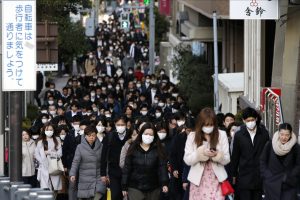On Monday, Prime Minister Shinzo Abe announced a month-long extension of Japan’s national emergency to help hospitals struggling with critically ill patients. The state of emergency was set to expire on Thursday but will stay provisionally in place until May 31.
During the Golden Week national holiday, the daily rate of infections appeared to be slowing down, with less than 100 new cases for five consecutive days. A panel of experts will reassess Japan’s coronavirus infection trends on May 14 and will consider whether the national emergency can be cut short before the end of the month.
In a televised press conference Abe issued an apology for not being able to complete the state of emergency by reaching a continuous level of 100 and fewer new COVID-19 cases in the first month. He called the extension a “preparatory period” for the government to transition toward reopening the economy.
Abe also pledged to expand PCR testing beyond the strict criteria and increase investment in the domestic production and importing of personal protective equipment.
All of Japan’s 47 prefectures are covered by the emergency declaration, but 34 prefectures will relax restrictions on movement and restart social and economic activities based on the infection rate of each region. On the other hand, 13 prefectures such as Tokyo and Osaka have been singled out as “special caution” prefectures, where “special emphasis” is needed to prevent the spread of COVID-19.
Although the stay-at-home and business closure requests carry no enforceable penalties, a state of emergency enables the government to temporarily use private land such as hotels and universities for medical care. The second leg of the state of emergency will be eased to allow the reopening of certain public facilities, such as libraries, museums, and parks, that can maintain social distancing and disinfection health precautions.
Japan’s state of emergency has been difficult to navigate amid the rigid lockdowns seen in other hard-hit countries such as Italy, Spain, France, and Britain. The coronavirus outbreak overseas was a warning to the rest of the world of the potential future. But the timeline of Japan’s coronavirus infection rate, the reluctance to test aggressively, and “voluntary” stay-at-home requests make it easy to feel caught between two conflicting realities.
Japan’s national emergency isn’t a black and white lockdown. Earlier this week Abe stressed that going out itself isn’t an issue, arguing that shutting down economic and social activities would make it impossible for people to make a living. The central government has concentrated public health countermeasures around lowering the risk of group transmission by reducing social interaction by 70 to 80 percent.
The Health Ministry unveiled comprehensive social guidelines under the “new way of life” plan, which aims to facilitate a “paradigm shift” likened to waging a long-term war against the coronavirus.
The new social guidelines highlight specific examples of social etiquette and personal hygiene when at the workplace, on public transport, shopping, organizing meet ups, eating in public places, and even attending funerals and weddings. Recommendations include standard hand washing with soap, using masks, and maintaining a two-meter distance from others at all times. But moving forward, the guidelines also emphasize avoiding in-person conversations, holding conversations on public transport, or sitting and eating side-by-side with someone. The Health Ministry also advises an immediate change of clothes when returning home.
Japan has managed to avoid an explosive outbreak and maintain a relatively low mortality rate, unlike other G-7 countries. But under a “voluntary” extended state of emergency, there are doubts as to whether the new lifestyle guidelines, tailored around each unique outside activity, can encourage a reduction of social interaction by 70 and 80 percent – and, in turn, how effective that will be in reducing the burden of overcrowded hospitals.
































